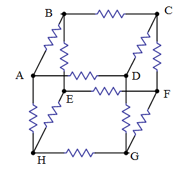Embibe Experts Solutions for Chapter: Solved Physics Paper-1, Exercise 1: Exercise
Embibe Experts Physics Solutions for Exercise - Embibe Experts Solutions for Chapter: Solved Physics Paper-1, Exercise 1: Exercise
Attempt the free practice questions on Chapter 15: Solved Physics Paper-1, Exercise 1: Exercise with hints and solutions to strengthen your understanding. Physics Crash Course (Based on Revised Syllabus-2023) solutions are prepared by Experienced Embibe Experts.
Questions from Embibe Experts Solutions for Chapter: Solved Physics Paper-1, Exercise 1: Exercise with Hints & Solutions
If the fringe width obtained in Young's double-slit experiment is , then on immersing the whole set up in the water with refractive index , new fringe width will be
Twelve resistors each of resistance are joined to form a cube as shown in the figure given below. Find the equivalent resistance between the diagonally opposite points and .

When the ether hypothesis was ended?
What do you know about radio-carbon dating ?
The output of an unregulated dc power supply needs to be regulated. Name the device that can be used for this purpose and draw the relevant circuit diagram.
Draw a circuit diagram of a junction diode in forward bias.
Show using a proper diagram how unpolarized light can be linearly polarised by reflection from a transparent glass surface.
A parallel beam of light falls normally on the first face of a prism of small angle.The portion of the beam which is refracted at the second surface is deviated through an angle of and the portion which is reflected at the second surface and emerges again at the first surface makes an angle of With the direction of the incident beam. Calculate the angle of the prism and the refractive index of glass.
